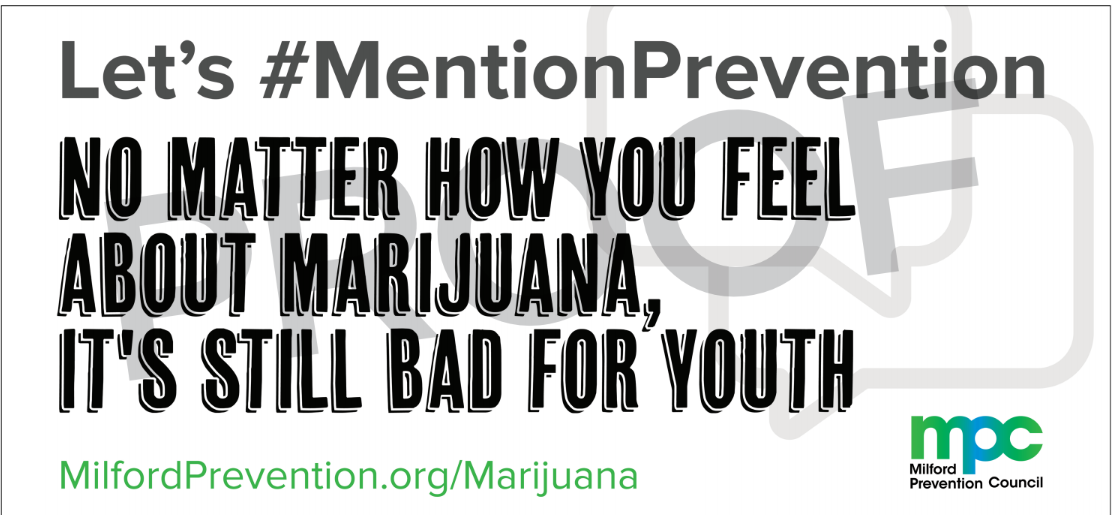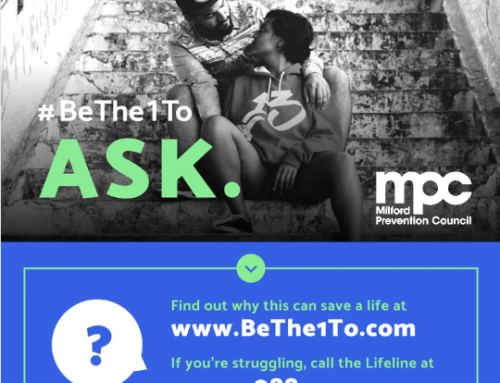Let’s #MentionPrevention: Marijuana
Source: https://talksooner.org/drug-trends/marijuana/
What is Marijuana?
Marijuana is the dried leaves and flowers of the plant Cannabis sativa or Cannabis indica . Stronger forms of the drug include high potency strains – known as sinsemilla (sin-seh-me-yah), hashish (hash for short), and extracts including hash oil, shatter, wax, and budder.
Of the more than 500 chemicals in marijuana, delta-9-tetrahydrocannabinol, known as THC, is responsible for many of the drug’s mind-altering (psychotropic) effects. It’s this chemical that distorts how the mind perceives the world. In other words, THC is what makes you high.
The marijuana “joint” (cigarette) is made from the dried particles of the plant. The amount of THC in marijuana determines how strong its effects will be.
The potency of today’s marijuana is as much as 10 times greater than the marijuana used in the early 1970s. Higher potency means there is greater physical and mental effects and the possibility of health problems for the user.
Marijuana is the most commonly used illicit drug in the United States by teens as well as adults. Recent public discussions about medical marijuana and the public debate over the drug’s legal status is leading to a reduced perception of harm among young people. In addition, some teens believe marijuana cannot be harmful because it is “natural,” but not all-natural plant substances are good for you—tobacco, cocaine, and heroin also come from plants.
Marijuana is a drug of convenience; for a relatively small amount of money, a person can buy enough that can be shared with several people but still transports easily in a pocket or bag. Marijuana can be purchased in almost any neighborhood in any city or state in the country. It is easily concealed, both for transport and use.
Along with legalization in some states, marijuana has become widely popular with adolescents or young adults who have a lot of authority figures involved in their lives. Unlike alcohol, where the signs of use are often overt and overwhelming, a marijuana user can often conceal their use in the event that they are under scrutiny, often with such simple remedies as a quick shower or a few drops of Visine.
Monitoring the Future survey of U.S. secondary school students indicates marijuana has been tried by 1 in 7 eighth graders and has been used in the prior month by about 1 in every 19. Some used it on a daily or near-daily basis. Statistics show that marijuana use commonly rises among 10th and 12th graders. Of perhaps greater importance is the rise in daily or near-daily marijuana use, defined as use on 20 or more occasions in the prior 30 days. For more statistics on teen drug use, see NIDA’s Monitoring the Future study and National Institute on Drug Abuse for Teens.
Risk behaviors associated with marijuana use can have harmful long-lasting effects on a teen’s health as well as being addictive. Approximately 10% of people who use marijuana may develop marijuana use disorder – problems with their health, school, friendships, family or other conflicts in their life. A serious substance use disorder is commonly called an addiction. The person can’t stop using marijuana even though it gets in the way of daily life. People who begin using marijuana before the age of 18 are 4–7 times more likely than adults to develop a marijuana use disorder.
Fast Facts
- Thirty-eight percent (38%) of high school students report having used marijuana in their life.
- Research shows that marijuana use can have permanent effects on the developing brain when use begins in adolescence, especially with regular or heavy use.
- Frequent or long-term marijuana use is linked to school dropout and lower educational achievement.
Risks Associated With Marijuana Use
- Reduced School Performance. Students who smoke marijuana tend to get lower grades and are more likely to drop out of high school than their peers who do not use. The effects of marijuana on attention, memory, and learning can last for days or weeks.
- Reduced Life Satisfaction. Research suggests that people who use marijuana regularly for a long time are less satisfied with their lives and have more problems with friends and family compared to people who do not use marijuana.
- Impaired Driving. Marijuana affects a number of skills required for safe driving—alertness, concentration, coordination, and reaction time—so it’s not safe to drive high or to ride with someone using marijuana. Marijuana makes it hard to judge distances and react to signals and sounds on the road. High school seniors who smoke marijuana are 2 times more likely to receive a traffic ticket and 65% more likely to get into an accident than other teens. In 2017, 10.3% of 12th graders reported driving after using marijuana in the past two weeks. And combining marijuana with drinking even a small amount of alcohol greatly increases driving danger, more than either drug alone. Learn more about what happens when you mix marijuana and driving.
- Use of Other Drugs. Most young people who typically use marijuana do not go on to use other drugs. However, those who use are more likely to use other illegal drugs. It isn’t clear why some people go on to try other drugs, but researchers have a few theories. The human brain continues to develop into the early 20s. Exposure to addictive substances, including marijuana, may cause changes to the developing brain that make other drugs more appealing. In addition, someone who uses marijuana is more likely to be in contact with people who use and sell other drugs, increasing the risk for being encouraged or tempted to try them.
- Severe Nausea and Vomiting. Studies have shown that in rare cases, regular, long-term marijuana use can lead some people to have cycles of severe nausea, vomiting, and dehydration, sometimes requiring visits to the emergency room.
For more information on the effects of marijuana, see NIDA’s Marijuana Research Report.
Behavioral Signs of Use
- Lack of motivation or ambition for activities that once excited the user.
- In many cases, participation in sports, social groups, or other pursuits will decrease or even cease entirely.
- Performance in school or in the workplace will begin to decline, coupled with a sense of apathy towards this decline.
- Withdrawal from the family system. This is most often the case with adolescents and young adults but can be a warning sign for adults as well.
- Drastic change in peer group. An addict will often abandon peer groups in favor of those who share similar desires and behaviors, namely those engaging in drug use.
- Personal hygiene may begin to suffer as he or she is less concerned with their public appearance.
- Depressive style of mood. Marijuana addicts manifest many of the same characteristics as those suffering from depression. An addict will have a flat affect and mood; he or she will appear lazy and day-to-day functioning will start to deteriorate on every major life level.
- Aversive, avoidant behavior.
Physical Signs of Use:
- Bloodshot eyes
- Slowed speech or reactions
- Averting eye contact or an unsteady gaze
- Rapid heart rate
- Increased blood pressure
- Increased rate of breathing
- Dry mouth
- Increased appetite, or “the munchies”
These effects are reduced after three or four hours. However, marijuana hangs around in your system for as long as 24 hours after smoking. The lingering effects mean you’re impaired for several hours after the high wears off.
Common Street Names
Marijuana is often referred to as:
- Weed
- Pot
- Aunt Mary
- BC Bud
- Chronic
- Doobie
- Dope
- Gangster
- Ganja
- Grass
- Hash
- Herb
- Joint
- Mary Jane
- Mota
- Reefer
- Sinsemilla
- Skunk
- Smoke
- Yerba
Learn More
How to Talk about Marijuana
The Drug Guide- Information Source for Parents
Marijuana Use and the Developing Teen Brain
Basic Facts for Parents
Marijuana: Common Myths as Reported by Youth
For more information, please reach out to Milford Prevention Council at [email protected]

